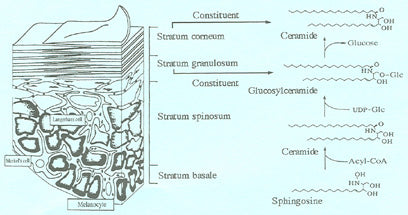Ceramide Biological
Biological Function of Ceramide in Human
Ceramide in Skin
The human skin consists of epidermis, corium and tela subcutanea. The epidermis was classified into four layers, namely stratum corneum, stratum granulosum, stratum spinosum and stratum basale.

Fig. Structure of Epidermis and Biosynthesis of Ceramides
Six different species of ceramide were found in skin. These ceramides were formed via several biosynthetic in epidermis, and were accumulated at stratum corneum as major constituent, about 40 to 60% of stratum corneum lipids. In epidermis, these ceramides play important roles for forming lamella phase and maintaining barrier functions.

Fig. Species and Structures of Ceramides
Quantity of ceramides was lower in the stratum corneum of atopic dermatitis, dry skin and aged individual. Study conducted by Imokawa et. al demonstrated that the ceramide content declines with increasing age. As the forearm skin of aged persons (especially those aged over 70 years old) are usually xerotic, hence that the decrease in ceramide content is associated with dry appearance in xerotic skin. In addition, comparison of total ceramide content of forearm stratum corneum between atopic dermatitis and healthy subjects shows that in atopic dermatitis, there is a marked in the amount of total ceramide in both lesional and non-lesional forearm skin as compared with that of healthy individuals of the same age.
This result suggested that ceramide is a key factor for moisturizer maintenance and barrier function of stratum corneum. Fine lines and wrinkles appear when ceramide content is reduced. Thus of ceramides is necessary for maintaining healthy youthful looking skin.

Fig. Total Ceramide Content of Stratum Corneum in Healthy Subjects

Fig. Comparison of Ceramide Content in Forearm Skin Between Atopic Dermatitis and Healthy Subject

